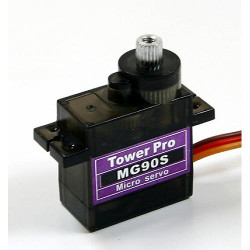Servo Motor¶
This example is based on the first servo I grabbed from my shelf
Note
TowerPro MG90S Micro servo (TowerPro site)

Accuracy¶
Default external measurements will be to specification (so you may use it in your own creations without issue).
Default internal measurements, and design will be estimated based on external observation; I’m not looking to infringe copyright.
What I design might actually work if you printed it, but that’s not the point of this exercise
Hierarchy¶
The servo’s Assembly contains the following Assembly and
Part instances:
servo
├── enclosure
│ ├─○ shell
│ ├─○ end_cap
│ └── fasteners
│ ├── front_left
│ │ ├─○ bolt
│ │ ├─○ washer (?)
│ │ └─○ nut
│ ├── front_right
│ │ ...
│ ├── back_left
│ │ ...
│ └── back_right
│ ...
├── gearbox
│ ├── bearing
│ │ ├─○ outer_ring
│ │ ├── rolling_elements
│ │ │ ├─○ ball_1
│ │ │ │ ...
│ │ │ └─○ ball_n
│ │ ├─○ retainer
│ │ └─○ inner_ring
│ ├─○ main_shaft
│ ├─○ middle_shaft
│ └─○ drive_shaft
├── motor
│ ├── base_bearing ...
│ ├── drive_bearing ...
│ ├── rotor
│ │ └○ shaft
│ └─○ stator
└─ driver
├── board
│ ├─○ pcb
│ ├── ... (components)
│ └─○ potentiometer
└─○ connector
Where:
─denotes anAssembly, and○denotes aPart
The idea being that following branches should always end in a Part
(so the ○ is a leaf)
Display¶
Todo
display completed servo example
from cqparts import display
# TODO: import Servo
servo = Servo() # use default values
display(
servo,
highlight=[
servo.find('gearbox.bearing'), # assembly (branch)
servo.find('motor.rotor.shaft'), # part (leaf)
],
)